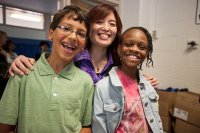Building Social and Emotional Skills in Elementary Students: The Power of Appreciation
In this nine-part series, we will look at important factors that influence the happiness and social and emotional learning of elementary school age children. These factors are very useful in helping students learn, manage emotions and increase empathy. Each blog features one letter of the acronym HAPPINESS:
H = Happiness
A = Appreciation
P = Passions and Strengths
P = Perspective
I = Inner Meanie, Inner Friend
N = Ninja Mastery
E = Empathy
S = So Similar
S = Share Your Gifts
In this article, we’ll explore appreciation, which is a pillar of happiness and one of the fastest ways to shift a student's mood and perspective. The definition of appreciation is "gratitude; thankful recognition." Developing gratitude helps students to focus on what is working in their lives, and also to train their minds to notice the good things that are all around. Learning to appreciate even the little things in life, such as a sunny day, a smile or a good meal, improves one's outlook substantially, and helps to develop a more optimistic and resilient attitude. What we focus on is what grows -- and gratitude promotes positivity.
Accentuate the Positive
Cultivating gratitude, which leads to positivity, is important in that it has a direct relationship to learning. According to Shawn Achor in his book The Happiness Advantage, "The brain at positive is 31% more productive is than the brain at negative, neutral or stressed." In addition, the hormone dopamine that floods the system at positive opens up the learning centers of the brain.
Gratitude works on two levels. It is one of the quickest ways to shift your perspective on perceived problems (external) and it is also an antidote to the inner "critic mind." If individuals are grateful for the small things, then the bigger issues can seem less daunting. On the inner level, when people practice noticing the good in others, they tend to be less judgmental with themselves -- that's important too!
In the classroom, the APA reported a recent study about the effects of gratitude on students aged 10-14. When comparing the results of the least grateful 20 percent of the students to the most grateful 20 percent, they found that, by the end of the four-year period, students with the most gratitude had:
- gained 15 percent more of a sense of meaning in their lives
- become 15 percent more satisfied with their lives overall (at home, at school, with their neighborhood, with their friends and with themselves)
- become 17 percent happier and more hopeful about their lives
- experienced a 13 percent drop in negative emotions and a 15 percent drop in depressive symptoms
The study concluded that increases in gratitude over a four-year period were significantly related to improvements in life satisfaction, happiness, positive attitudes and hope.
Teaching Gratitude
The good news is that gratitude is something that can be taught. The more that gratitude and appreciation are practiced, the more this perspective becomes second nature. The scientific explanation is that repeated behavior changes the neuropathways of the brain. When specific skillsets are learned and practiced, they strengthen the happiness centers in the brain.
Here are some easy ways to bring the benefits of gratitude and appreciation to your classroom:
- Consider starting each day with a Gratitude Check-In. Students can either tell the person next to them or write in a gratitude journal three things they are thankful for that day. Scientific studies have shown how this quick activity can bring significant results. It's a simple and effective way to shift a student's mind to positive, which enhances learning and gets the day off to good start.
- Have students write a gratitude letter to someone who has influenced or touched their lives in a positive way, someone who has inspired them or who has been especially kind and caring. Ideally, the student would deliver the letter in person and watch the person's face as they read it. Then it is the student who should be prepared for hugs and appreciation! If it is not possible to deliver the letter, the mere act of writing it (or for younger kids, just speaking it) has proven benefits as well.
- Another powerful facet of appreciation is when teachers express appreciation to students. This "thankful recognition" can be expressed for many reasons, including when students help out in the classroom, help another student in some way, or even when they pay attention in class. It reinforces what is expected in class and, more than that, it rewards cooperation, kindness and initiative. These are behaviors and attitudes that directly help with classroom management. When students are recognized for positive behavior, it contributes to creating a contagiously positive atmosphere. Who could argue with that? Look for reasons to express appreciation to students, and you may be pleasantly surprised!
Find lesson plans and additional resources at projecthappiness.org. Meanwhile, please share how you've noticed the benefits of appreciation in the classroom.
